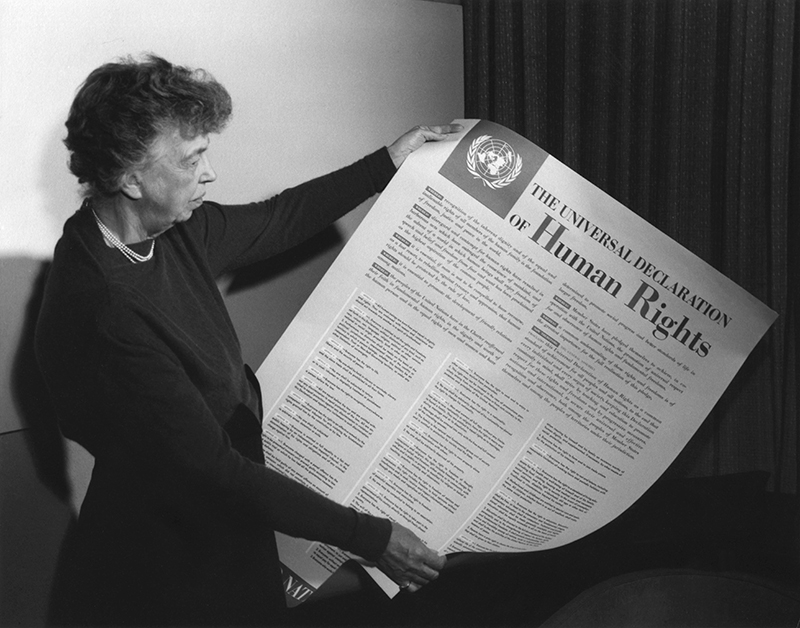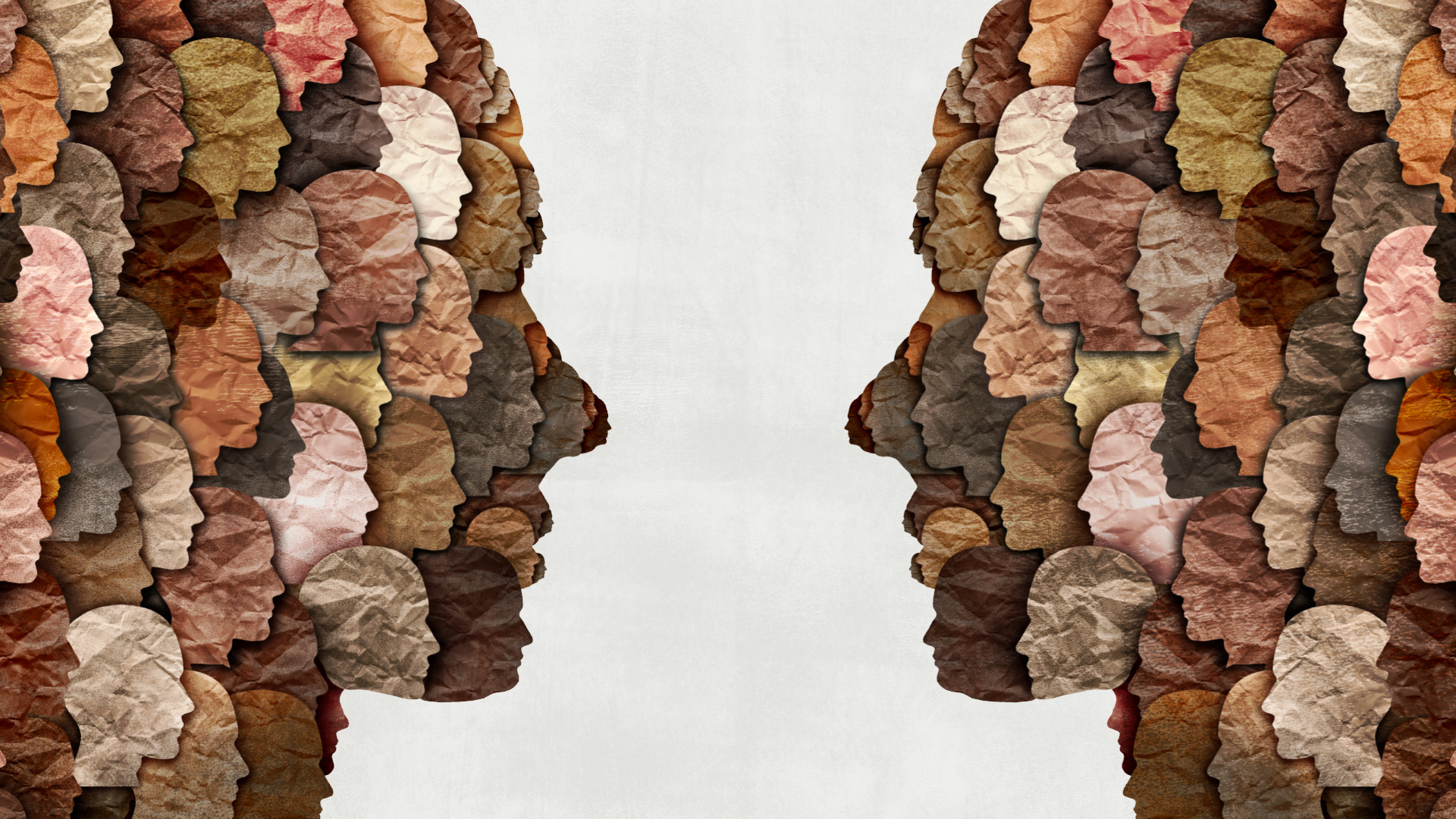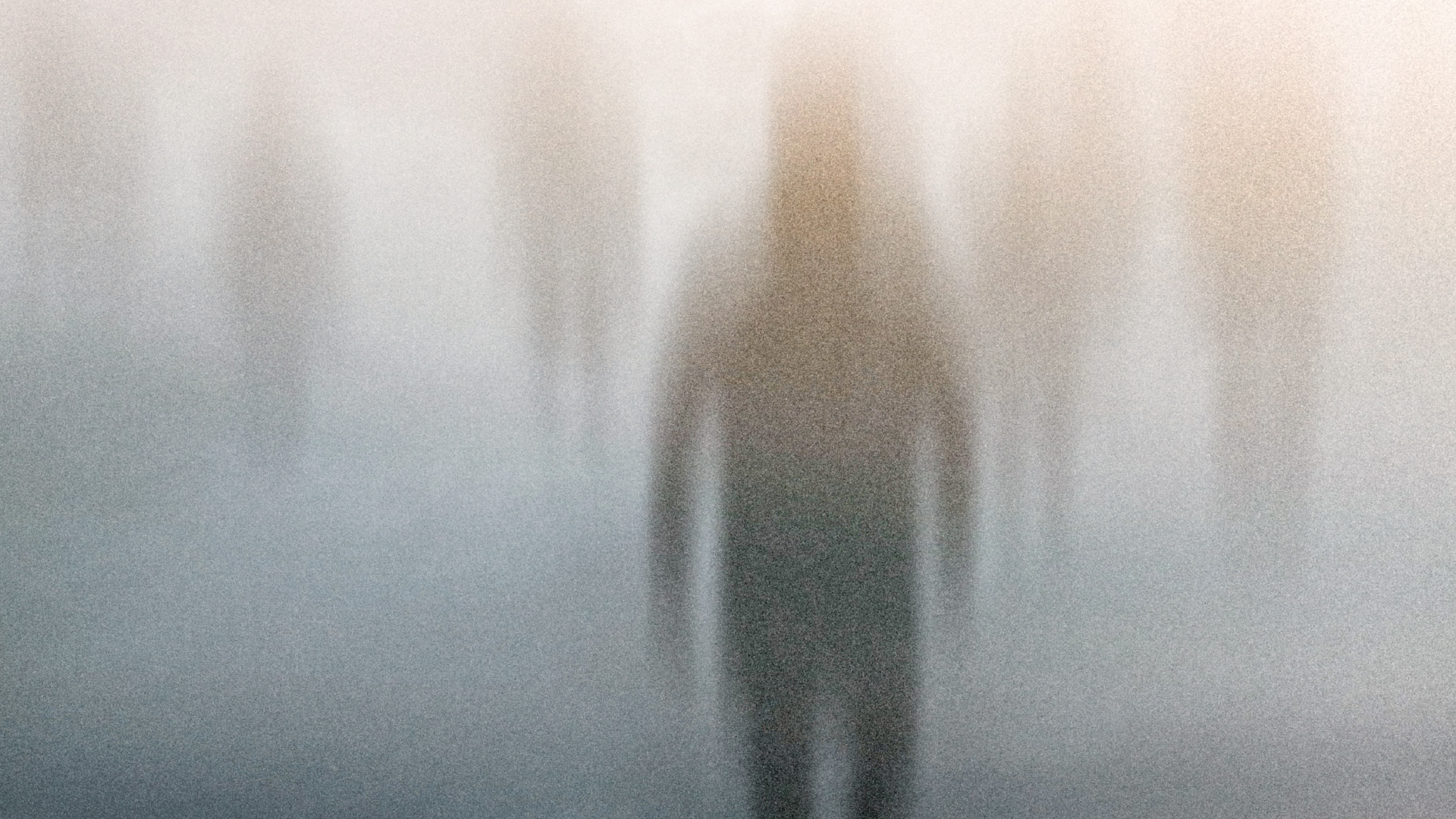Human Rights, Human Responsibilities
Almost 4,000 years after King Hammurabi codified laws addressing what we now think of as human rights, how far have we really come?
On December 10, 1948, while the world was still reeling from the human devastation caused by two world wars, the United Nations adopted an extraordinary document. It was the first modern instrument identifying innate human rights—considerations that are neither earned nor granted by any governing society, and that should, by undisputed right, be universally protected for all people.
The Universal Declaration of Human Rights (UDHR) is still the document all international law builds on. As the United Nations commemorated its 75th anniversary in 2023, secretary-general António Guterres noted that “the Declaration described, for the first time, entitlements that apply to everyone, everywhere, always,” setting out “the rights to life, liberty and security; to equality before the law; to freedom of expression; to seek asylum; to work, to healthcare and education, and more.” In a similar vein, Volker Türk, the UN’s high commissioner for human rights, called on the international community to reflect on the declaration and recommit to “advancing its promise of freedom, equality, and justice for all.”
Woven through the UDHR mandate to establish a just world without oppression and inequality is a fundamental understanding: Humanity can accomplish this audacious goal only if all people, and the societies they live in, accept the responsibility for promoting, protecting and ensuring those rights.
Fair enough. But what does that mean, practically speaking?
Before we answer this question in the light of the UDHR, it might be useful to acknowledge how consistently such discussions have cropped up over the course of human history.
Justifying Justice
The idea that we’re entitled to certain things simply because we’re human is not new; a long history points to how widespread this concept has been. One of the early attempts to codify humanitarian justice dates to the 18th century BCE, when the Babylonian king Hammurabi set out 282 laws for the governance of his empire—many of which addressed what we now think of as human rights. In the words of historian Paul Gordon Lauren, “the code presents some of the earliest examples of the right to freedom of speech, the presumption of innocence, the right to present evidence, and the right to a fair trial by judges.” Lauren adds that Hammurabi’s famous code also included protections for those in society who are easily taken advantage of, including slaves, women, widows and orphans, and those living in poverty.
As another example, Lauren refers to the Law of Moses in the kingdom of ancient Israel: “Provisions in Mosaic Law that address what we would now describe as early conceptions of human rights are explicit about the necessity of fulfilling responsibilities toward others under the law (including six of the Ten Commandments).” Lauren explains that this extended legal code was concerned with “applying rules of justice to individuals both friend and stranger, free and slave, man and woman, young and old, rich and poor, and healthy and disabled.”
“The long-standing and widespread interest in justice is evident from the very beginnings of civilization itself.”
This is far from an exhaustive account of civilizations that have attempted to codify what it means to afford the dignity and respect that all human beings could claim. Some have called these “God-given” or “inalienable” rights.
Of course, as Lauren points out, regardless of how inalienable these rights are understood to be, there have always been those who—while willing to claim these rights for themselves—have had a vested interest in withholding them from others. The underlying interests behind human rights violations may include greed, privilege, prejudice or simply the preservation of power. But whatever the motive, human nature (apparently as inalienable as human rights) ensures that rights codes alone are not enough to prevent abuses. Like any other laws, those that define human rights don’t mean much unless they’re enforced, and enforcing them isn’t easy. Pointing to the US Constitution’s Bill of Rights, Lauren names slavery, segregation, lynching and gender discrimination as just a few examples of how attempts to enforce such rights have faced enduring challenges.
The fact that these kinds of violations are still prevalent signifies an inseparable connection between the concepts of “rights” and “responsibilities.” In other words, we can establish that equality, for instance, is a right due to all people. But unless we follow laws that spell out what we owe to others to make sure they enjoy the same treatment we enjoy—or make a personal commitment to treat others equitably even where there are no laws requiring it—it becomes all too easy for us to claim our own rights at their expense. “Law establishes responsibilities owed to others in society,” Lauren writes. “It is for this reason that the ideas about human duties, or what one is due to do, lead quite naturally to ideas of human rights, or what is due to one.”
To simplify that thought in “social justice math,” we could say that what’s required of us in our behavior toward others is the flip side of what we believe is due to us. By now, we may be recognizing the essence of what’s known as the Golden Rule.
Whose Responsibility?
In 1955 Alabama, seven years after the United Nations adopted the UDHR, Rosa Parks became famous in the United States for defying a law that relegated African Americans to the back of the bus. Nine months after a similar challenge by 15-year-old Claudette Colvin, this act (which could have gotten them arrested or physically attacked) helped ignite the civil rights movement in America. But the tragedy of their story is that such an act was even necessary. Their right to equal treatment—already enshrined in their own nation’s Bill of Rights and, on the international level, in the UDHR—should have been ensured by those in their community who wouldn’t have been subject to the same risk that Colvin and Parks faced for claiming it.
Those with means and power carry a compelling responsibility to ensure the equitable treatment of those who are without means and power. But each of us carries the same grave responsibility toward all others, regardless. It shouldn’t come to the point where those who are oppressed are forced to take great risks to secure for themselves the “inalienable” human rights already enjoyed by those around them.
“It is patent that certain outwardly peaceful and secure situations do not spring from genuine justice and therefore are not worth maintaining. . . . There is a peace that only cloaks terrible inner conflicts, and there is a security that is utterly insecure.”
It’s ironic that America, whose own record on human rights was far from pristine at the time, was on the front line of the push to include human rights as a key purpose of the UN Charter. With a few other exceptions, the subject of human rights wasn’t on the radar for most of the delegates from 50 countries who met in San Francisco at the April 1945 UN founding conference. At the time, the “Big Three” allies (Britain, the Soviet Union and the United States) had invited representatives from every nation that had declared war on Germany and Japan by March 1 of that year. Early drafts of the UN Charter resulting from that first meeting mentioned human rights only once, an inclusion that then–US president Franklin Roosevelt considered vital. Britain and the Soviet Union agreed to its inclusion but rejected the American proposal that it should be considered among the UN’s main purposes.
Also notable for their efforts to bring human rights to the forefront were Philippine general Carlos Romulo, Australian foreign minister Herbert Evatt and Lebanese diplomat Charles Malik—each motivated by different aims.

Eleanor Roosevelt, as chair of the committee tasked with laying the groundwork for the Universal Declaration of Human Rights, inspects a poster-sized copy of the finished product.
For Romulo, the driving force was the harm inflicted by colonialism and racial discrimination—two very visible stains on America’s shirtfront at the time. The Philippines was a US colony, and the dawn of America’s civil rights movement was still a decade away. Evatt’s position on human rights was that economic and social justice had to be the basis of any permanent peace. He saw the Great Depression as the catalyst for the rise of totalitarian regimes that instigated World War II, and he insisted that the antidote was full employment and freedom from want. Malik’s view was that a failure to address human rights was a failure to address the very causes of the international conflicts that the United Nations was being established to prevent.
Two of these men—Romulo and Malik—would end up on the committee to frame the Universal Declaration of Human Rights alongside Eleanor Roosevelt, who was unanimously elected as chair. Now a widow, the former First Lady had been appointed by her husband’s successor, Harry Truman, as a member of the US delegation to the United Nations. Only one senator opposed her nomination: Mississippi’s Theodore Bilbo objected on the basis of Mrs. Roosevelt’s zeal for racial equality.
“As in Eleanor Roosevelt’s famous adage that human rights begin ‘in small places, close to home’, it is in the personal sphere that we first apply our values and experience our rights and freedoms.”
With Roosevelt as chair, China’s Peng-chun (P.C.) Chang as vice-chair and Malik as secretary, the Human Rights Commission got to work. It took nearly two years—and overcoming a number of obstacles—to draft and adopt the UDHR in its final form.
During the drafting phase, of course, international conflict remained the status quo. Various policies on the part of both the United States and the Soviet Union served to strain relations between the two nations, marking the start of the Cold War. China was in the midst of a civil war, with one side backed by US government forces. Conflict ravaged the Middle East, exacerbated after the United Nations adopted a resolution recommending the partitioning of Palestine into an Arab state and a Jewish state.
Laying a Cornerstone for World Peace
In 1946, the United Nations decided that respect for human rights would be a central concern, hoping to limit armed conflict and promote peace. Eleanor Roosevelt chaired the committee tasked with laying the groundwork for the permanent Commission for Human Rights. She later noted, “Many of us thought that lack of standards for human rights the world over was one of the greatest causes of friction among the nations, and that recognition of human rights might become one of the cornerstones on which peace could eventually be based.”
To formulate an international bill of rights, the Commission would need wide-ranging input. John P. Humphrey, director of the UN Secretariat’s Division for Human Rights, gathered ideas and proposals. UNESCO sought input from academics and intellectuals representing diverse political, philosophical and religious traditions. It was an arduous process to distill the vast amount of material into an organized declaration consisting of a preamble and 30 articles.
Though the Universal Declaration passed unanimously in December 1948, the ongoing effort to relate human rights to individual duties was arduous. Mahatma Gandhi had answered the UNESCO request, recalling his mother emphasizing that “all rights to be deserved and preserved came from duty well done.” This led him to state that “the very right to live accrues to us only when we do the duty of citizenship of the world. From this one fundamental statement, perhaps it is easy enough to define the duties of Man and Woman and correlate every right to some corresponding duty to be first performed. Every other right can be shown to be a usurpation hardly worth fighting for.”
Similarly, the Chinese philosopher and historian Lo Chung-Shu had described the need for rights to match duty when he defined the underlying value as “the sympathetic attitude of regarding all one’s fellow men as having the same desires, and therefore the same rights, as one would like to enjoy oneself.”
More than 70 years later, these wise words sound a clarion call in a world where human rights and human response in terms of personal responsibility are still under great stress.
Today little has changed. Conflict and rampant violations of basic human rights still haven’t taken a back seat to social justice and equity.
One could argue—as the Human Rights Commission delegates from the USSR, Byelorussia, Ukraine and Yugoslavia did when they abstained from voting on the final draft—that declaring human rights without naming who is responsible for policing them accomplishes little. The preamble addresses responsibility by calling on “every individual and every organ of society” to secure their observance. But as world events continue to demonstrate, not every individual nor every organ of society has accepted that responsibility—or has even read the UDHR.
In A World Made New, former US ambassador Mary Ann Glendon writes that “the Declaration’s framers did not imagine in 1948 that they had discovered the whole truth about human beings and human rights. They never claimed that the document they had produced in difficult circumstances represented the last word”; in fact, they commonly acknowledged that it was far from perfect. Rather, she says, “the dominant metaphor was that of an important milestone on a long and difficult journey.” Their hope was that its exercise would lead to deeper understanding in the future.
“Human rights do not replace private ethical and moral choices, nor public, political and policy decisions with legal ones. Instead, they should inform all of these.”
That future hope, according to Glendon, relies on humanity’s relationship with truth. She sees a level of vulnerability to political manipulation in the UDHR, pointing to the declining belief in the existence of moral truths. “One hopes the trend is a passing one,” she writes, “for to accept that faith is surely to invite the coming of a very dark age. It is one thing to acknowledge that the human mind can glimpse truth only partially, quite another to deny its existence altogether.”
One truth Glendon observes is that the declaration’s provisions grew out of many national and historical human rights instruments. These provisions reflect familiar themes in some of the humanitarian and religious texts that Lauren cited, as noted above. Its statement of responsibility for all people is that we “should act towards one another in a spirit of brotherhood.”
Lauren refers to similar statements of responsibility in the Mosaic law. “The injunctions are clear,” he writes. “‘You shall not oppress . . . You shall do no injustice . . . You shall love your neighbor as yourself.’” These laws were considered so binding, Lauren notes, that when abuses occurred, the nation’s leaders were openly challenged to address them, “as Isaiah forcefully did with his charge ‘to loose the bonds of wickedness, to undo the tongs of the yoke, to let the oppressed go free . . . to share your bread with the hungry, and to bring the homeless poor into your house’, and thereby ‘bring justice to the nations’.”
What Lauren calls a clear injunction in Mosaic law is no less binding today. At some point in the future, Glendon reminds us, our present generations will be remembered for how we succeeded—or didn’t—in our duty of care for one another as human beings.
What will our legacy be?



